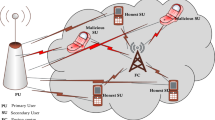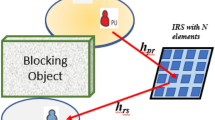Abstract
To overcome the frequency spectrum scarcity, cognitive radio (CR) network is proposed where secondary users opportunistically use vacant frequency band. CR intrinsic properties impose threats to these wireless networks. Smart primary user emulation attack (PUEA) is one of these threats where a malicious user performs spectrum sensing and after being aware of radio environment sends fake signals identical to the primary user signals with the desired signal occurrences in both vacant and occupied licensed frequency bands. In this paper, while considering smart PUEA, we propose a soft cooperative spectrum sensing method. In this method, the sensing information values of N secondary users are transmitted to the fusion center (FC) and combined with some coefficients with the aim of minimizing the error probability of primary user detection, under the given constant false alarm probability. We also propose a method for quantization of this sensing information that should be sent to FC. Furthermore, we have worked on the investigation of channel estimation error impact on detection performance. Simulation results show that our method significantly improves the spectrum sensing probability of the error, in comparison with hard combination scheme, AND fusion and OR fusion rules, either considering quantization or in the presence of channel estimation error.








Similar content being viewed by others
References
Alahmadi A, Abdelhakim M, Ren J, Li T (2014) Defense against primary user emulation attacks in cognitive radio networks using advanced encryption standard. IEEE Trans Inf Forens Secur 9(5):772–781
Cabric D, Mishra SM, Brodersen RW (2004) Implementation issues in spectrum sensing for cognitive radios. In: Conference record of the thirty-eighth Asilomar conference on signals, systems and computers, vol 1. IEEE, pp 772–776
Chen C, Cheng H, Yao YD (2011) Cooperative spectrum sensing in cognitive radio networks in the presence of the primary user emulation attack. IEEE Trans Wire Commun 10(7):2135–2141
Chen R, Park JM (2006) Ensuring trustworthy spectrum sensing in cognitive radio networks. In: SDR’06.1 st IEEE Workshop on networking technologies for software defined radio networks. IEEE, pp 110–119
Chen R, Park JM, Hou YT, Reed JH (2008) Toward secure distributed spectrum sensing in cognitive radio networks. IEEE Commun Mag 46(4):50–55
Digham FF, Alouini MS, Simon MK (2007) On the energy detection of unknown signals over fading channels. IEEE Trans Commun 55(1):21–24
Fragkiadakis AG, Tragos EZ, Askoxylakis IG (2013) A survey on security threats and detection techniques in cognitive radio networks. IEEE Commun Surveys Tutor 15(1):428–445
Ganesan G, Li Y (2007) Cooperative spectrum sensing in cognitive radio, part i: two user networks. IEEE Trans Wireless Commun 6(6):2204–2213
Ganesan G, Li Y (2007) Cooperative spectrum sensing in cognitive radio, part ii: multiuser networks. IEEE Trans Wireless Commun 6(6):2214–2222
Ghasemi A, Sousa ES (2005) Collaborative spectrum sensing for opportunistic access in fading environments. In: First IEEE international symposium on new frontiers in dynamic spectrum access networks, 2005. DySPAN 2005. IEEE, pp 131–136
Haghighat M, Sadough SMS (2014) Cooperative spectrum sensing for cognitive radio networks in the presence of smart malicious users. AEU-Int J Electron Commun 68(6):520–527
Haykin S (2005) Cognitive radio: brain-empowered wireless communications. IEEE J Selected Areas Commun 23(2):201–220
Kay SM (1998) Fundamentals of statistical signal processing: detection theory, vol 2
Ma J, Zhao G, Li Y (2008) Soft combination and detection for cooperative spectrum sensing in cognitive radio networks. IEEE Trans Wireless Commun 7(11):4502–4507
Mishra SM, Sahai A, Brodersen RW (2006) Cooperative sensing among cognitive radios. In: 2006 IEEE International conference on communications, vol 4. IEEE, pp 1658–1663
Papoulis A, Pillai SU (2002) Probability, random variables, and stochastic processes. Tata McGraw-Hill Education
Proakis JG, Salehi M, Zhou N, Li X (1994) Communication systems engineering, vol 94. Prentice Hall New Jersey
Qin Z, Li Q, Hsieh G (2013) Defending against cooperative attacks in cooperative spectrum sensing. IEEE Trans Wireless Commun 12(6):2680–2687
Rawat AS, Anand P, Chen H, Varshney PK (2011) Collaborative spectrum sensing in the presence of byzantine attacks in cognitive radio networks. IEEE Trans Signal Process 59(2):774– 786
Shrivastava S, Rajesh A, Bora PK (2014) Sliding window dixon’s tests for malicious users’ suppression in a cooperative spectrum sensing system. IET Commun 8(7):1065–1071
Urkowitz H (1967) Energy detection of unknown deterministic signals. Proc IEEE 55(4):523–531
Yadav S, Nene MJ (2013) Rss based detection and expulsion of malicious users from cooperative sensing in cognitive radios. In: 2013 IEEE 3rd International of advance computing conference (IACC). IEEE, pp 181–184
Author information
Authors and Affiliations
Corresponding author
Rights and permissions
About this article
Cite this article
Emami, M., Jabbarpour, M.R., Abolhassani, B. et al. Soft Cooperative Spectrum Sensing using Quantization Method in the Presence of Smart PUE Attack. Mobile Netw Appl 22, 650–659 (2017). https://doi.org/10.1007/s11036-016-0802-9
Published:
Issue Date:
DOI: https://doi.org/10.1007/s11036-016-0802-9




